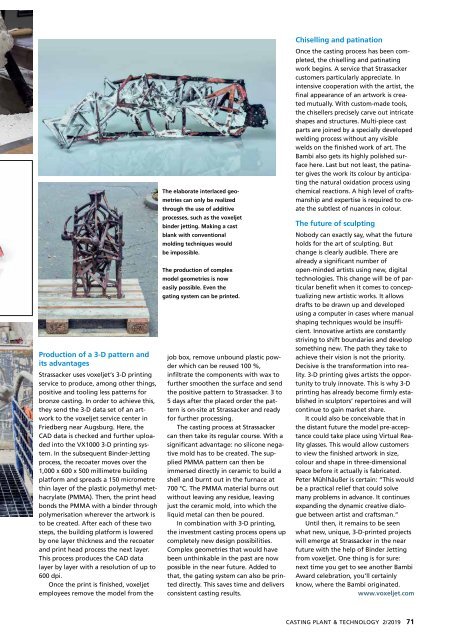CPT International 02/2019
- No tags were found...
Create successful ePaper yourself
Turn your PDF publications into a flip-book with our unique Google optimized e-Paper software.
Production of a 3-D pattern and<br />
its advantages<br />
Strassacker uses voxeljet‘s 3-D printing<br />
service to produce, among other things,<br />
positive and tooling less patterns for<br />
bronze casting. In order to achieve this,<br />
they send the 3-D data set of an artwork<br />
to the voxeljet service center in<br />
Friedberg near Augsburg. Here, the<br />
CAD data is checked and further uploaded<br />
into the VX1000 3-D printing system.<br />
In the subsequent Binder-Jetting<br />
process, the recoater moves over the<br />
1,000 x 600 x 500 millimetre building<br />
platform and spreads a 150 micrometre<br />
thin layer of the plastic polymethyl methacrylate<br />
(PMMA). Then, the print head<br />
bonds the PMMA with a binder through<br />
polymerisation wherever the artwork is<br />
to be created. After each of these two<br />
steps, the building platform is lowered<br />
by one layer thickness and the recoater<br />
and print head process the next layer.<br />
This process produces the CAD data<br />
layer by layer with a resolution of up to<br />
600 dpi.<br />
Once the print is finished, voxeljet<br />
employees remove the model from the<br />
The elaborate interlaced geometries<br />
can only be realized<br />
through the use of additive<br />
processes, such as the voxeljet<br />
binder jetting. Making a cast<br />
blank with conventional<br />
molding techniques would<br />
be impossible.<br />
The production of complex<br />
model geometries is now<br />
easily possible. Even the<br />
gating system can be printed.<br />
job box, remove unbound plastic powder<br />
which can be reused 100 %,<br />
infiltrate the components with wax to<br />
further smoothen the surface and send<br />
the positive pattern to Strassacker. 3 to<br />
5 days after the placed order the pattern<br />
is on-site at Strassacker and ready<br />
for further processing.<br />
The casting process at Strassacker<br />
can then take its regular course. With a<br />
significant advantage: no silicone negative<br />
mold has to be created. The supplied<br />
PMMA pattern can then be<br />
immersed directly in ceramic to build a<br />
shell and burnt out in the furnace at<br />
700 °C. The PMMA material burns out<br />
without leaving any residue, leaving<br />
just the ceramic mold, into which the<br />
liquid metal can then be poured.<br />
In combination with 3-D printing,<br />
the investment casting process opens up<br />
completely new design possibilities.<br />
Complex geometries that would have<br />
been unthinkable in the past are now<br />
possible in the near future. Added to<br />
that, the gating system can also be printed<br />
directly. This saves time and delivers<br />
consistent casting results.<br />
Chiselling and patination<br />
Once the casting process has been completed,<br />
the chiselling and patinating<br />
work begins. A service that Strassacker<br />
customers particularly appreciate. In<br />
intensive cooperation with the artist, the<br />
final appearance of an artwork is created<br />
mutually. With custom-made tools,<br />
the chisellers precisely carve out intricate<br />
shapes and structures. Multi-piece cast<br />
parts are joined by a specially developed<br />
welding process without any visible<br />
welds on the finished work of art. The<br />
Bambi also gets its highly polished surface<br />
here. Last but not least, the patinater<br />
gives the work its colour by anticipating<br />
the natural oxidation process using<br />
chemical reactions. A high level of craftsmanship<br />
and expertise is required to create<br />
the subtlest of nuances in colour.<br />
The future of sculpting<br />
Nobody can exactly say, what the future<br />
holds for the art of sculpting. But<br />
change is clearly audible. There are<br />
already a significant number of<br />
open-minded artists using new, digital<br />
technologies. This change will be of particular<br />
benefit when it comes to conceptualizing<br />
new artistic works. It allows<br />
drafts to be drawn up and developed<br />
using a computer in cases where manual<br />
shaping techniques would be insufficient.<br />
Innovative artists are constantly<br />
striving to shift boundaries and develop<br />
something new. The path they take to<br />
achieve their vision is not the priority.<br />
Decisive is the transformation into reality.<br />
3-D printing gives artists the opportunity<br />
to truly innovate. This is why 3-D<br />
printing has already become firmly established<br />
in sculptors’ repertoires and will<br />
continue to gain market share.<br />
It could also be conceivable that in<br />
the distant future the model pre-acceptance<br />
could take place using Virtual Reality<br />
glasses. This would allow customers<br />
to view the finished artwork in size,<br />
colour and shape in three-dimensional<br />
space before it actually is fabricated.<br />
Peter Mühlhäußer is certain: “This would<br />
be a practical relief that could solve<br />
many problems in advance. It continues<br />
expanding the dynamic creative dialogue<br />
between artist and craftsman.”<br />
Until then, it remains to be seen<br />
what new, unique, 3-D-printed projects<br />
will emerge at Strassacker in the near<br />
future with the help of Binder Jetting<br />
from voxeljet. One thing is for sure:<br />
next time you get to see another Bambi<br />
Award celebration, you’ll certainly<br />
know, where the Bambi originated.<br />
www.voxeljet.com<br />
CASTING PLANT & TECHNOLOGY 2/<strong>2019</strong> 71

















